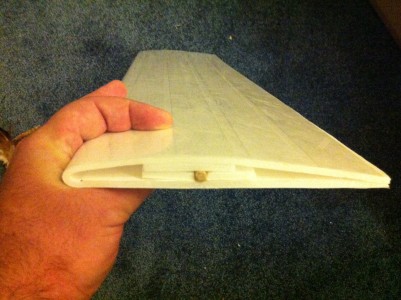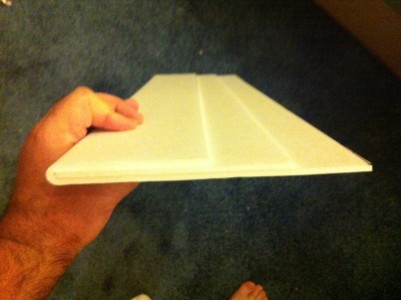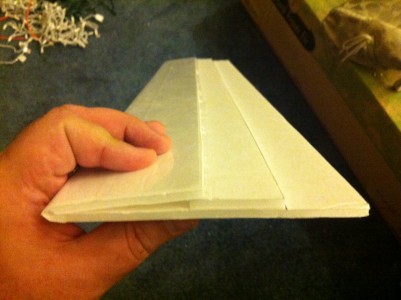Okay, I haven’t had much time to work on RC airplanes. I’ve been meaning to try to find something a little tamer than my Nutball to fly (it seems to be a bit twitchy) but I haven’t really done too much other than watch videos on YouTube and scout around on the rcgroups forums for inspiration. But I have been thinking alot about wings, and wing fabrications. I ended up making three different wings from Dollar Tree foamboard, and thought it might be nice to show what they look like, and what I learned in building a few of them.
The first of these is the so-called Armin Wing, championed by Ed on the Experimental Airlines channel. I’ve made a few versions of these. The nice thing about these is that they have a nice airfoil shape. The version that I have here isn’t the fancy version, with the knife-edge trailing edge, but it’s pretty nice. I used a piece of 3/16″ dowel to stiffen it (carbon fiber would be better, but I was just experimenting).
Ed’s videos show in great detail how to make these, if they interest you, go review those. The one disadvantage is that they are a little bit involved, compared to the two designs that follow, but they aren’t really difficult, and I suspect that they might perform better than simple KFm airfoils, although mine have pretty blunt leading edges, which could make for higher drag than you might like, at least for high speed flights.
While watching flitetest’s video on Airfoils, they constructed a KFm3 style stepped airfoil to replace a damaged wing on their Cessna model. They didn’t go into any details on how they did it, but I thought it might be pretty easy. The airfoil has steps at 50% and 75% of the wing chord, so I cut a piece which was 12″x30″, and another which was 6″x30. I folded the 12″x30″ piece 4″ back from the leading edge, and clamped and glued it around the 6″ piece, resulting in a wing with an 8″ chord, and three thicknesses of foamboard. Because there was so much area to be glued, I didn’t use hot glue, I used Gorilla glue, and clamped it for a couple of hours. It worked, but also had a blunt leading edge. Not sure I liked it.
The “So” design that I linked in my last posting was also a KFm3 wing, but constructed a bit differently. This wing has a 6″ chord, so you begin by cutting a 9″x30″ of foamboard, and then score halfway through it 3″ back from one edge. You then cut a shallow bevel on either side, so you can fold it back. A piece 1.75″ wide is first glued 1.5″ back from the trailing edge, and then the bevelled part folded back and glued to the top edge of the 1.75″ piece. Okay, that’s a crappy description, but here’s the result. The bevel allows the leading edge to be sharper than the previous one.
All three seem credible designs. I probably will use the third technique if I go with the KFm3 style wing. I like the So design, so I might try putting one together shortly, although I’m considering the “trainer” mods (polyhedral wing, with rudder rather than aileron). But the Armin wings aren’t that much harder, and make for kind of a spiffy looking wing.
Stay tuned for more foamboard madness. The cat is enjoying playing with the scraps at least.
Addendum: The KFm3 wing can be scaled up. Check out this video of a 96″ version (almost 5x the size of the one I just put together):


